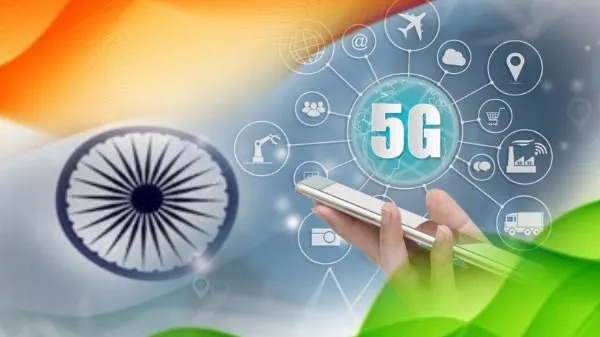5G can be instrumental in achieving Aatmanirbharta, while also contributing to an economy of $10 trillion.
With 5G auctions over on 26 July 2022, India gears up to enter the fifth era of Internet, which is estimated to contribute $450 billion to the Indian economy. Apart from higher bandwidth and subsequently faster speed, 5G offers various advantages, as it is the first generation internet that is capable of deeply altering and redesigning the current digital landscape by embedding more intelligent autonomous sensors and devices than ever into our internet. Before we delve into what 5G can bring to the Indian economy, we must have a look at the ongoing endeavours in the direction of internet’s reachability. With the BharatNet Scheme being implemented across India to connect villages via broadband, and the ever-expanding reach of 4G networks, there exists a vast network that has brought about ground-breaking changes. However, there are still gaps and imperfections in this network, with regards to latency, speed, and most importantly coverage. The advent of 5G is expected to neutralise these imperfections, and thrust India towards its economic goals, and thus attempts to tackle these challenges and offer immense potential in achieving the goal of surpassing the $10 trillion economy mark.
For India, 5G represents significant new opportunities for the $10 trillion digital economy envisioned by expert economists. It builds on the expansion of 4G that led to an orbital shift in data consumption; India’s data consumption per smart phone stands at 18.4 GB per month while the world average is at 11.9. This in turn led to the expansion of sectors such as e-tailing, digital marketing, online food delivery, edtech, digital payments, tele-medicine, by way of increased connectivity, faster access to data, seamless transactions, and expanding markets. Using the Internet, governments have improved citizen delivery services at much lower costs, and have been able to achieve last mile connectivity. It has brought traditional businesses and crafts online and has assisted small and big businesses alike in enlarging their customer base. The expansion of high-speed and low-cost internet that 5G has to offer will thus play a role in the growth of a majority of sectors in India. In the era of toothbrush apps, preponderance of 5G should help in enlarging the range of goods and services being offered, expanding the customer base and thus leading to economic growth. Another advantage to be noted is that 5G is being developed in the country and is not an imported technology, as was the case with 4G. This is a big leap towards self-sustainability and ultimately in achieving Aatmanirbharta. This will reduce costs, create jobs, help us achieve invaluable experience in infrastructure building and potentially give us useful insights when it comes to developing future generations of the internet. While fibre optic cables have been around for quite some time, and have proved to be the fastest means of transmitting data, it depends on physical infrastructure to be laid across an area, which ensures end-to-end connectivity. Although 5G will use fibre optic cables, or a phenomenon known as “fiberization”, by way of connecting two towers to transmit data, which will eliminate the need for end user fibre infrastructure installation. The fibre infrastructure is connected intercontinentally through undersea cables, which not only disturbs the marine habitat, but also increases the possibility of interference and vulnerability significantly, and also requires regular maintenance and repair, which in turn increases the costs. This work may be significantly reduced with the advent of 5G, which uses a closely knit network of base stations to transmit data, thereby reducing the cost of achieving comparable speeds to fibre optic cables and reducing the need for end to end fibre connections.
While the advantages of 5G are innumerable, we must realise the challenges that are attached with it. One such challenge is the cost of implementation to companies, which will ultimately affect the consumer. For using 5G, consumers would need 5G compatible devices, which would be sold at a comparatively higher price. Though as 5G phones or other devices become readily available, the average selling price is likely to come down.
But for now, they remain out of reach for millions of people. The pricing of the 5G spectrum is also several times costlier than the global average, which will be of detriment to India’s cash-strapped telcos such as Vodafone Idea Limited. With Jio pushing for the auction for quite some time now, and the latest addition of Adani in the 5G bidding war, a total of 4 companies will now hold the monopoly of 5G in the market, as many other telecom operators had a hard time finding a level playing field, and will look to up their buying power by taking on more debt.
With fibre infrastructure not yet spanning across India, it remains to be seen how quickly 5G can take over and replace the need for end to end fibre connectivity. The infrastructure needed for 5G is a significant upgrade over the existing 4G infrastructure, and as such will take a few years for fruition.
India is one of the major countries working towards developing 5G technology challenging the Chinese giant Huawei cited as a threat to national security by various countries. With only 7% of the world currently having access to 5G, India could be one of the earliest countries which would adopt 5G at a large scale. In order to achieve India’s economic goals, it is pertinent to realise the capabilities, hurdles, and the way forward when it comes to the setting-up of 5G networks. It is the next logical step in the direction of our digital growth, after UPI, One Nation One Ration Card (ONORC), and Open Network for Digital Commerce (ONDC). 5G can be instrumental in achieving Aatmanirbharta, while also contributing to a rising economy of $10 trillion.
The author is Research Analyst at Nation First Policy Research Centre.

